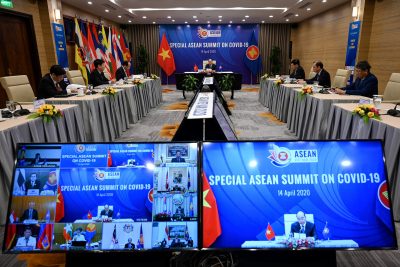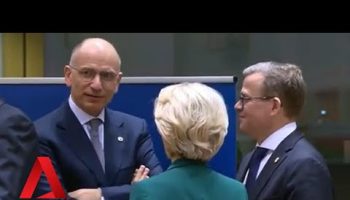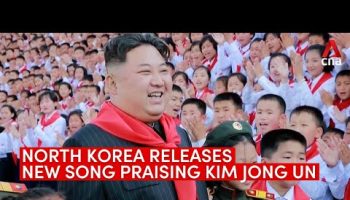Author: Frederick Kliem, RSIS
COVID-19 is testing international resolve to cooperate. Both China and the United States have so far failed to provide the necessary global leadership. The World Health Organization (WHO) and the United Nations (UN) play — at best — the role of supporting actors. Even the European Union and ASEAN are struggling with outbreaks of nationalism and unilateral knee-jerk reactions.

Southeast Asia’s interconnectedness makes it highly vulnerable to pandemics. Tourism, trade and supply chains deeply intertwine Southeast with China, which contributed to the spread of COVID-19 within the ASEAN region, as well as South Korea and Japan.
Southeast Asia has been badly affected by COVID-19. While case numbers are hardly comparable due to asymmetric testing, all 10 ASEAN member states seem to have woken up to the crisis and are engaging in some form of pandemic management. The challenge now is to coordinate responses at the regional level.
In a virtual summit on 14 April 2020, ASEAN leaders agreed on a ‘whole-of-ASEAN community approach’ to combat the virus. Leaders agreed to the inauguration of a common COVID-19 response fund prepared by the foreign ministers in an earlier conference, the details of which are being worked out. Consensus was also reached on the need to address the situation on the frontline with joint procurement of medical supplies and stockpiling.
ASEAN leaders agreed to extensive sharing of information and best practices. On their recommendation, a virtual ASEAN Defence Senior Officials’ Meeting (ADSOM) took place on 15 May to discuss, among other things, the ASEAN Center of Military Medicine (ACMM) as a suitable platform for table-top exercises on COVID-19 responses and pandemic preparedness in general. More immediate is the initiation of joint cross-border responses to retain the smooth functioning and openness of essential supply chains and trade routes to protect food security and the exchange of medical equipment.
Intra-ASEAN bilateral cooperation has been strengthened. Malaysia initially reacted to the pandemic with restrictions on the movement of people and goods across borders, including the causeway with Singapore, a critical supply route. This caused substantial problems in Singapore and led to panic buying and stranded Malaysian workers. Since then, both countries have established a special working committee to manage any complications caused by respective lockdown measures.
Though the COVID-19 Special ASEAN Summit provided much needed political momentum, the effectiveness of this regional response now depends on timely implementation. Vietnam, as the current chair of ASEAN, must initiate frequent leaders, ministers and officials conferences to ensure ASEAN can implement agreements made at the summit.
The postponement of the ASEAN–US Special Summit demonstrated the stress COVID-19 puts on ASEAN centrality.
ASEAN initiated a special ASEAN+3 (ASEAN, China, Japan and South Korea) video conference where leaders agreed to strengthen early pandemic warning and real-time information exchange and to set-up a regional ASEAN+3 medical supply stockpile. They committed to ensuring the continuous flow of commodities, food and medical supplies across Southeast Asia. ASEAN+3 leaders also specifically emphasised food security and the utilisation of the ASEAN+3 Emergency Rice Reserve, a common stockpile to ensure emergency food supply in times of adversity.
ASEAN managed to get a commitment from its partners to contribute to its COVID-19 Response Fund by re-prioritising and reallocating the substantial existing cooperation funds.
Pandemic management begins with independent and verifiable oversight of case numbers, death rates and the effectiveness of individual measures. But historically, independent monitoring in ASEAN member states has been a challenge.
With the implementation of the ASEAN Charter and the ASEAN Community, transparency improved to some extent as stocktaking of Community implementation became more common. But ASEAN monitoring of domestic public policy and crisis management in individual member states remains a sensitive matter and COVID-19 is not likely to change that as governments may be incentivised to under-report.
There are steps ASEAN can take to limit the impacts of COVID-19 and future pandemics.
First, comprehensive implementation of the leaders’ summit agreements needs to be ensured. ASEAN must strengthen regional crisis support networks to ensure it can meet its members’ needs. The reactivation and utilisation of the ASEAN Technical Working Group on Pandemic Preparedness and Response can help to suppress COVID-19 by sharing experiences from countries such as Singapore and Vietnam, and provide a set of minimum standards for pandemic management across the region.
A regional response also requires strengthening the capacity of the ASEAN Centre for Humanitarian Assistance on Disaster Management (AHA Centre). This is where joint procurement and stockpiling of essential medical supplies and equipment can be coordinated — the AHA centre manages common warehouse and reserve facilities for regional HADR.
Second, possibly also via the AHA Centre, ASEAN should become the first responder and strive for expertise across its membership. Laos and Cambodia appear to be relying on third parties, particularly China, to address much of their COVID-19 needs due to highly inadequate healthcare systems.
Singapore is Southeast Asia’s medical centre of excellence and is home to a thriving health tourism industry. The city-state has 2.5 physicians per 1000 people (whereas Laos has only 0.5). The temporary secondment of doctors and health experts can alleviate pressure on stressed health care systems.
Third, ASEAN possesses the resources to build a sufficient stockpile and has systems in place to distribute medical equipment. ASEAN should call on its ASEAN+3 partners to support the stockpiling of medical equipment, financially and materially — any such contribution is in the interest of all members.
Fourth, ASEAN can facilitate best practice sharing for pandemic management, such as Singapore’s contact tracing and Vietnam’s holistic mobilisation. The bilateral Singapore–Malaysia Committee can also translate into broader ASEAN-wide institutionalisation of crisis border management. Under the auspices of ADSOM this can, for example, take place within the ACMM, and should be extended to ASEAN+3.
National emergency measures must be transparent, reciprocal and cooperative. To this end ASEAN leaders agreed to create guidelines for the implementation of travel and trade restrictions. The free flow of goods, services and — most importantly — people, is imperative for successful regional integration. Mutual trust and support must be reflected in equal treatment of each other’s citizens who stay, work or study across the ASEAN region or in third countries.
ASEAN has done reasonably well compared to the European Union, despite the latter’s substantially larger resources. ASEAN should build on it response to COVID-19 so that history will note the disaster as a driver of stronger cooperation in Southeast Asia.
Dr Frederick Kliem is a Fellow at the S Rajaratnam School of International Studies (RSIS), Nanyang Technological University (NTU), Singapore.
This article is part of an EAF special feature series on the novel coronavirus crisis and its impact.





